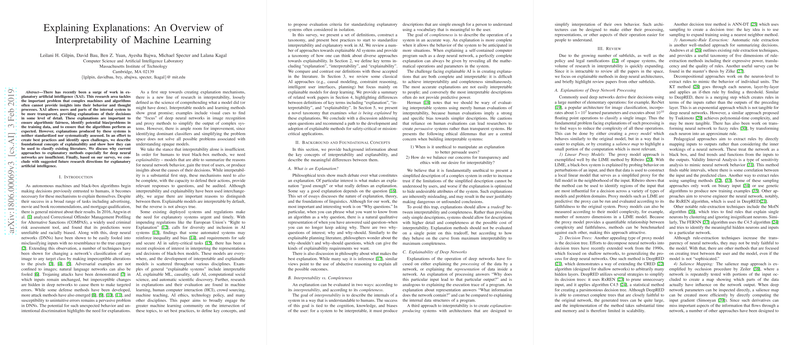An Overview of Interpretability of Machine Learning
The paper "Explaining Explanations: An Overview of Interpretability of Machine Learning" by Gilpin et al. provides a comprehensive survey on the domain of Explainable Artificial Intelligence (XAI), a rapidly growing research area that aims to elucidate the inner workings of machine learning models, particularly deep neural networks (DNNs). This work is timely given the widespread deployment of opaque machine learning models in critical applications requiring transparency and trust.
Key Concepts and Definitions
The authors emphasize the distinction between interpretability and explainability. Interpretability refers to the ability to describe a model's internal mechanisms in human-understandable terms. On the other hand, explainability encompasses interpretability but goes further to provide detailed justifications for a model's behavior and decisions. The paper argues that while interpretability alone is valuable, explainability is necessary for building trust and ensuring the correct and fair operation of machine learning systems.
Challenges in Deep Neural Networks
The paper details several challenges that highlight the need for explainability in DNNs. Notable examples include the occurrence of adversarial attacks, where imperceptible changes to inputs can lead to misclassifications across both image and natural language processing tasks. Another example is the COMPAS criminal risk assessment tool, which has been shown to exhibit racial bias. These challenges underscore the necessity for systems that can provide transparent and justifiable explanations of their outputs to mitigate risks of bias and to ensure operational fairness.
Taxonomy of Explanations
The paper introduces a novel taxonomy categorizing approaches to explainability into three main types:
- Processing Explanations: These methods aim to explain how a model processes input data to reach a decision. Examples include proxy models such as LIME, decision trees like DeepRED, and salience maps that highlight sensitive regions, such as those produced by Gradient-based methods. Each method reduces the complexity of operations in the network to produce a simplified but meaningful explanation of the decision process.
- Representation Explanations: These approaches seek to elucidate how input data is represented within a model. For instance, network dissection quantitatively assesses the role of individual units in learning hierarchical features. Techniques such as Concept Activation Vectors (CAVs) align interpretable human concepts with directions in the representation space to determine what concepts a network has learned.
- Explanation-Producing Systems: These are self-explaining models designed with architectures that inherently make their decisions more interpretable. Examples include attention-based models, disentangled representations, and systems that generate natural language explanations. Attention mechanisms, for example, can visually point out which parts of the input are most relevant for the decision, providing a form of explanation that is both interpretable and reliable.
Evaluation Methods
The authors propose several evaluation metrics for judging the quality of explanations:
- Completeness Relative to the Original Model: This metric assesses how faithfully a simplified explanation approximates the decision-making of the original complex model.
- Completeness on Substitute Tasks: These evaluations measure an explanation's ability to capture relevant model behaviors by testing it on related but simpler tasks.
- Detection of Biases: This involves evaluating whether explanations can effectively highlight biases present in the model, which is crucial for ensuring fairness and improving trust.
- Human Evaluation: Direct human assessment of explanation quality and usefulness, often through tasks designed to gauge understandability and the practical impact of explanations.
Implications and Future Directions
This detailed taxonomy and evaluation framework serve multiple implications for both theoretical understanding and practical applications of machine learning. From a theoretical perspective, the delineation between interpretability and explainability is crucial for driving forward research in each of these areas. Practically, the authors emphasize the importance of establishing standardized methods for evaluating and comparing different explanation approaches to guide practitioners in selecting the most appropriate methods for their needs.
Looking ahead, several promising avenues for future research are suggested, including the need for unified metrics that balance interpretability and completeness, and the pursuit of explanation methods that generalize across diverse application domains. Further interdisciplinary collaboration is recommended to integrate insights from fields such as cognitive science and human-computer interaction into the development of more effective and user-friendly explanatory systems.
Conclusion
The paper by Gilpin et al. offers a thorough examination of the current landscape of explainable AI, presenting key definitions, challenges, and a structured taxonomy of existing methods. By proposing a clear set of evaluation criteria, the authors lay the groundwork for future advancements in the field, highlighting the importance of XAI in building trustworthy and transparent AI systems. Their work underscores the necessity of balancing simplicity with accuracy in explanations, a crucial consideration for the continued adoption and trusted use of AI technologies in sensitive and critical domains.
